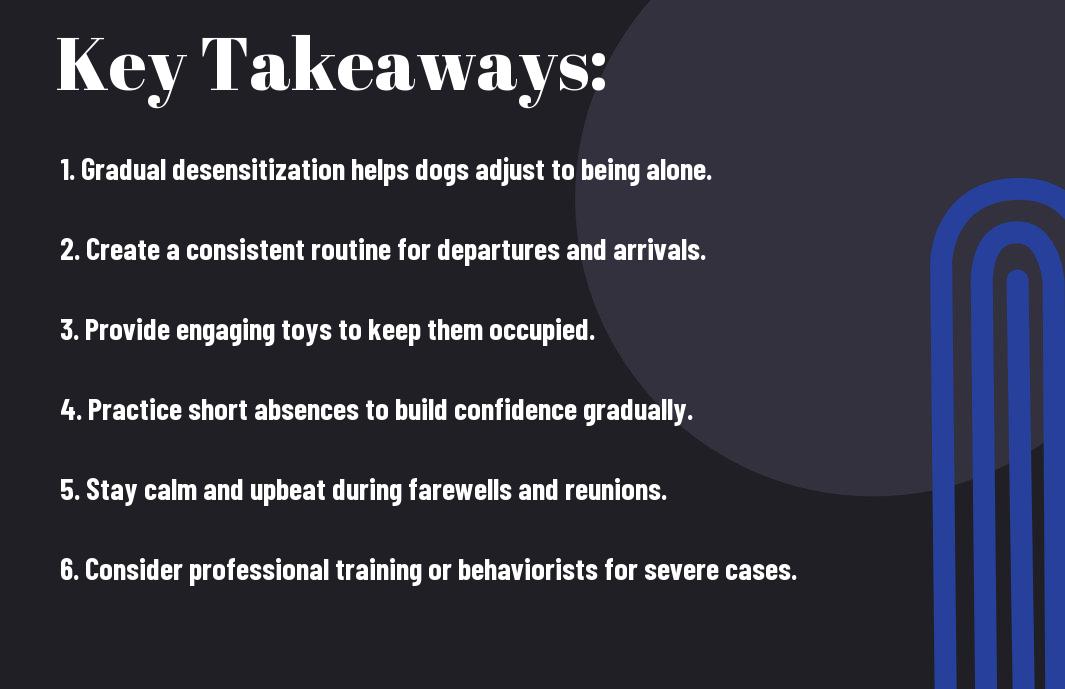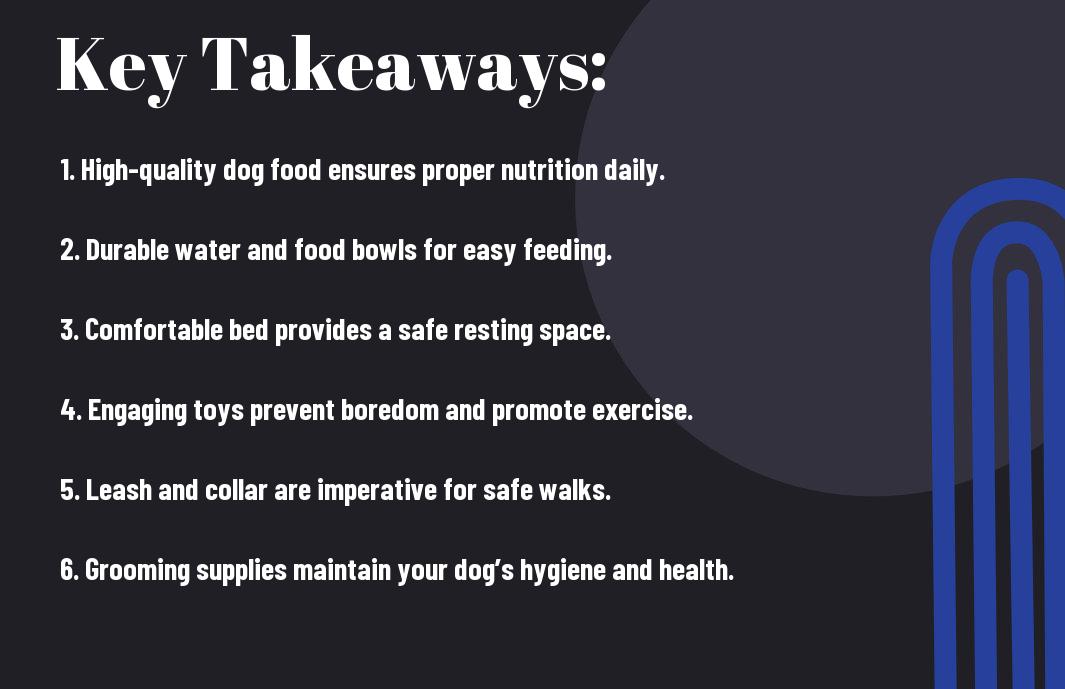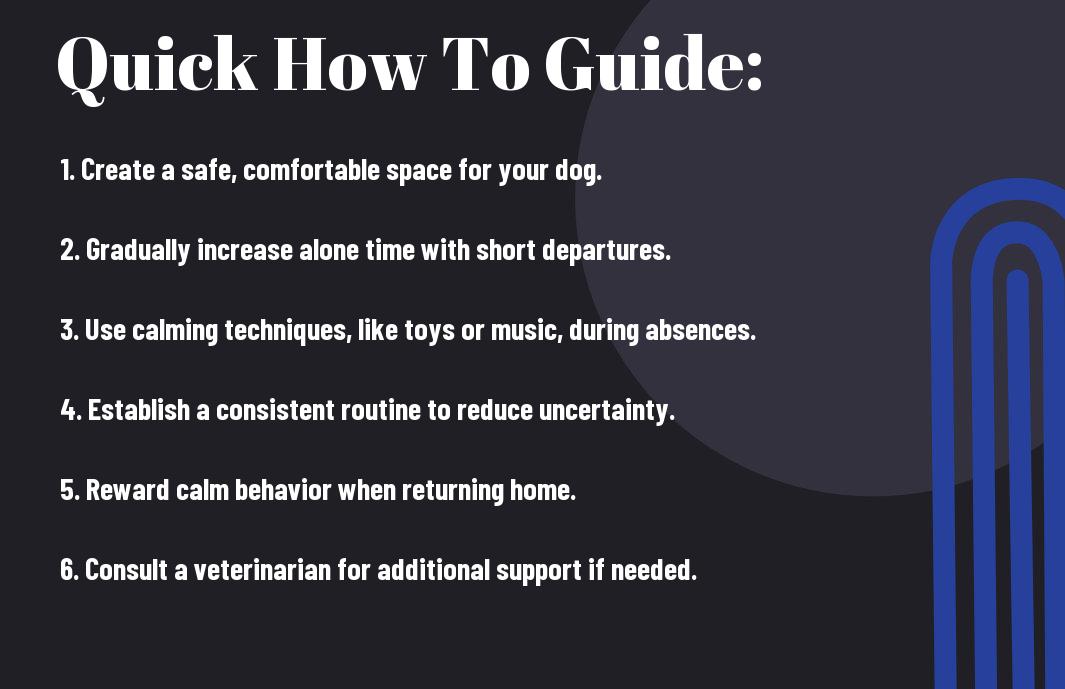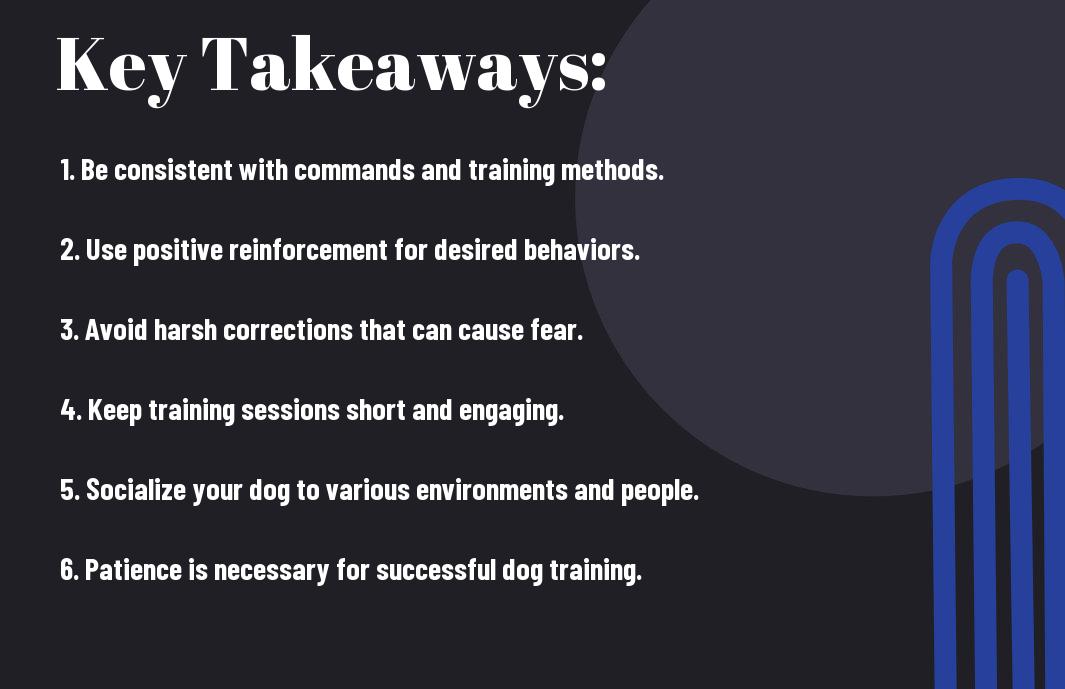Dogs often experience separation anxiety, which can manifest in destructive behaviors or excessive barking when left alone. As a responsible pet owner, it’s crucial for you to understand and implement effective strategies to help alleviate your dog’s stress. By establishing a consistent routine, providing engaging distractions, and gradually increasing your time apart, you can create a more comfortable environment for your beloved companion. This guide will equip you with the tools necessary to tackle separation anxiety, ensuring a smoother transition for both you and your furry friend.

Understanding Separation Anxiety in Dogs
Definition of Separation Anxiety
Anxiety in dogs can manifest in various forms, but one of the most challenging issues you may face as a pet owner is separation anxiety. This condition occurs when your dog experiences intense distress when left alone or separated from you. It isn’t merely a matter of your dog being bored or mischievous; it involves a deep-seated fear of abandonment that can trigger a myriad of behavioral problems.
Dogs suffering from separation anxiety often exhibit profound emotional distress and may struggle to cope with being left alone. This can lead to destructive behaviors, excessive barking, and even physical symptoms such as drooling or pacing. By understanding this condition, you can provide the necessary support and strategies to help your dog feel more secure.
Common Signs and Symptoms
The signs of separation anxiety can vary significantly from dog to dog, but there are several common symptoms that you should be aware of. Excessive barking, howling, whining, and destructive behavior are typical indicators. You might notice your dog chewing furniture, digging at doors, or scratching at windows in an attempt to escape. Furthermore, some dogs may urinate or defecate indoors despite being house trained, which can be distressing for both you and your pet.
Physical signs such as drooling, panting, and pacing may also become evident when your dog feels anxious about separation. In more extreme cases, dogs may exhibit behaviors like trying to escape the home, putting themselves at risk of injury. It’s important to identify these signs early, so you can address the issue effectively.
Due to the intense emotional turmoil associated with this condition, separation anxiety can change the way your dog interacts with the world. Understanding what to look for helps pave the way for effective management strategies that can assist your furry friend in coping more comfortably with your absences.
Causes of Separation Anxiety
Any dog can develop separation anxiety, but certain factors may put your pet at a higher risk. Life changes, such as moving to a new home, changes in family structure, or the loss of a companion animal can all contribute to the development of this issue. Additionally, dogs that have been abandoned or re-homed may have a heightened sense of insecurity that predisposes them to anxiety.
Some breeds are also more susceptible to separation anxiety, particularly those known for their loyalty and close bonds with their owners. Understanding the underlying causes of your dog’s anxiety can assist you in devising a more targeted approach to alleviate their distress.
Even if your dog has shown signs of stress in the past, it’s important to address the issue compassionately. Every dog is unique, and understanding the specific reasons for their anxiety will help you create a supportive environment that promotes their emotional well-being.

Assessing the Severity of Anxiety
Even if your dog’s separation anxiety seems mild, it’s important to assess its severity to determine the appropriate intervention strategies. Understanding the intensity of your dog’s anxiety can help you provide better support and manage the situation effectively. This involves observing their behavior, identifying potential triggers, and seeking professional advice if necessary. Each dog is unique, and the level of anxiety they exhibit can vary significantly, making it imperative to conduct a thorough assessment.
Observing Behavior Patterns
About observing your dog’s behavior when left alone can provide valuable insights into their anxiety levels. Note how they react when you prepare to leave, such as gathering your belongings or putting on shoes. Common signs of anxiety might include excessive barking, whining, pacing, destruction of household items, or attempts to escape. Keep a detailed record of these behaviors, as they can indicate the severity of your dog’s problem and guide your next steps.
Additionally, pay attention to how long these behaviors last after you’ve left. If your dog settles down within a few minutes, it may suggest a milder form of anxiety. However, if they continue to show distress for hours after you’ve left, this might indicate a more severe issue that requires attention. By carefully observing these behavioral patterns, you create a baseline understanding to work from as you implement strategies for your dog’s separation anxiety.
Identifying Triggers
For effectively managing your dog’s separation anxiety, it’s imperative to identify the specific triggers causing distress. Triggers can range from certain sounds, interactions, or even routines that precede your departure. For instance, if your dog becomes anxious when they see you preparing to leave or when they hear the door close, these are crucial moments to note.
To gain clarity on what specifically triggers anxiety in your dog, consider keeping a journal of events leading up to your departures. This will help you notice patterns that may not be immediately apparent. By pinpointing these triggers, you can better prepare your dog and potentially desensitize them to the various elements causing stress, ultimately helping reduce their anxiety over time.
Consultations with a Veterinarian
Any assessment of your dog’s separation anxiety should also involve a consultation with a veterinarian. They can help rule out any underlying medical issues contributing to your dog’s anxiety and provide guidelines on behavior modification techniques tailored to your dog’s unique situation. A vet may also discuss the possibility of medication to help your dog cope during the transition period, making it easier to implement training strategies.
Even if you believe separation anxiety is solely behavioral, a veterinarian’s expertise can ensure that your dog’s health and well-being are prioritized. Their experience and knowledge of canine behavior can be invaluable in helping you create a comprehensive plan tailored to your dog’s needs. By collaborating with a vet, you can feel more confident in your approach to managing your dog’s anxiety effectively.
Implementing Prevention Strategies
Keep in mind that managing separation anxiety in dogs begins with proactive prevention strategies. By implementing these techniques before your dog exhibits severe anxiety, you can cultivate a more relaxed environment, making transitions easier for both you and your furry friend.
Gradual Desensitization
With gradual desensitization, you’ll expose your dog to the situations that trigger their anxiety in a controlled manner. Start by leaving your dog alone for short periods while you are in another room or just outside the door. As your dog becomes more accustomed to your absence, you can gradually extend the length of time you leave them alone. This process helps your dog to understand that you will return and that solitude doesn’t equate to abandonment.
Throughout this process, be patient and sensitive to your dog’s reactions. If your dog shows signs of stress, reduce the length of time you’re gone and allow them to adjust before gradually increasing it again. The key is to create positive experiences around your departures.
Creating Positive Associations
Below are some methods for creating positive associations with your departures. One effective tactic is using treats or toys that your dog loves, which they can only access when you leave. For instance, give them a stuffed Kong or a puzzle toy filled with their favorite snacks right before you step out the door. This not only keeps them occupied but also reinforces that your leaving leads to something enjoyable.
Associations formed during your departures can significantly influence how your dog feels when you leave. If your departure becomes synonymous with treats or fun toys, your dog may learn to associate your absence with something positive rather than a moment of anxiety and distress. This method helps lay the groundwork for a more secure and calm state of mind when you are away.
Routine Establishment
An established routine can also play a vital role in alleviating your dog’s separation anxiety. By having a consistent schedule for feeding, walks, and playtime, your dog begins to understand what to expect from their day. This predictability reduces stress and fosters a sense of security, making it easier for them to cope when you leave.
Establishment of a daily routine helps your dog gain confidence as they learn the patterns of their environment. Dogs thrive on predictability, and a set schedule allows them to anticipate your presence and recognizes the normal ebb and flow of daily life. With a stable routine, transitions can feel less sudden and more manageable, creating a calmer atmosphere for your dog.

Training Techniques for Managing Anxiety
To effectively manage your dog’s separation anxiety, implementing specific training techniques can be highly beneficial. These methods target the root causes of anxiety instead of merely addressing the symptoms. By using consistent and positive reinforcement strategies, you can cultivate a sense of security in your dog, enabling them to feel more comfortable when left alone.
Counterconditioning Methods
With counterconditioning, you can change your dog’s emotional response to being alone. This approach involves associating your absence with something positive. For instance, you might start by leaving your dog alone for brief periods while providing a special treat or toy that they only receive during these moments. Gradually increase the duration of your absence while continuing to reward them, which reinforces a positive experience instead of dread when you leave.
Over time, these positive associations can help to lessen the anxiety your dog feels about separation. It’s vital to monitor your pet’s stress signals during the process. If your dog seems overly distressed, consider decreasing the time they are left alone and increase reward opportunities to help them adjust more comfortably.
Crate Training Strategies
Behind effective crate training lies the understanding that a crate should represent a safe haven for your dog, not a punishment. By introducing the crate gradually and positively, you can help your dog view it as their personal space where they feel secure. Start with short periods of confinement while providing comfortable bedding and suitable toys, encouraging them to see it as a cozy spot rather than a place of isolation.
Consequently, crate training can be an effective tool in managing your dog’s anxiety. Establish a routine that includes crate time during the day when you are at home, making it a normal part of their environment. Additionally, practice leaving the house briefly while your dog is in the crate, gradually increasing the time as they become more comfortable. Maintain a calm demeanor during departures and arrivals to avoid heightening their anxiety levels.
Using Puzzle Toys and Interactive Feeders
Training your dog to use puzzle toys and interactive feeders can significantly help in alleviating separation anxiety. These toys not only serve as a distraction during your absence but also mentally stimulate your dog, keeping them engaged and occupied. Introduce the toys when you are still at home, ensuring your dog associates them with fun and rewards. This creates a positive environment that will hold their attention when left alone.
Toys that dispense treats or require problem-solving can channel your dog’s energy and curiosity, diverting their focus from your absence. It’s imperative to regularly rotate these toys to maintain their novelty and effectiveness, ensuring your dog remains engaged and challenged. This approach not only decreases anxiety but also promotes cognitive development and keeps your dog happy when you need to be away.
Environmental Modifications
Once again, making specific adjustments in your dog’s environment can significantly help in managing their separation anxiety. This can be achieved by focusing on creating a sense of safety and comfort for your furry friend, allowing them to feel more relaxed when you are away. The environment you provide plays a vital role in how your dog copes with being alone. You can take meaningful steps to create a space that feels secure and soothing.
Safe Spaces and Comfort Items
Environmental modifications begin with establishing a safe place where your dog can retreat when they feel anxious. This area should be quiet and free from distractions, equipped with their favorite blankets, toys, and other comfort items that carry their scent. These familiar items can provide a sense of security, helping to alleviate feelings of stress. You want to ensure that the safe space is easily accessible and can be your dog’s go-to spot when they need a little extra reassurance.
Adjusting Home Environment
On another note, adjusting the home environment can significantly impact your dog’s emotional well-being. Consider aspects such as eliminating loud noises, reducing sudden changes in routine, and providing plenty of natural light. In addition, using soothing scents like lavender or chamomile can create a calming atmosphere. A quiet environment free from sudden disturbances will help make your dog feel more comfortable when left alone.
In addition, keeping your dog’s area organized and clutter-free is important. This not only reduces visual stimuli that can contribute to anxiety but also ensures your dog can navigate their environment without obstacles. By making these thoughtful adjustments, you enhance your dog’s sense of security, directly impacting their ability to cope with separation.
Techniques for Reducing Stimuli
Around your home, implementing techniques to reduce stimuli is vital to managing your dog’s separation anxiety. This can involve things like using sound machines to provide soothing background noise, which helps mask any potentially distressing sounds coming from outside. Another effective method is to employ calming music specifically designed for dogs, creating an environment that promotes relaxation while you are away.
Plus, consider utilizing visual barriers such as baby gates or curtains to limit your dog’s view of the outside world. Being able to see activity outside can prove overwhelming and anxiety-inducing. By minimizing visual triggers and creating a peaceful environment, you not only help your dog feel safe but also contribute to a more relaxed state when you leave the house. These modifications can create a well-rounded approach to managing separation anxiety in your beloved pet.
Professional Support and Therapy Options
After implementing some initial self-help techniques, you may find that your dog’s separation anxiety requires a more structured approach. Engaging with professionals can provide valuable support to help your furry companion cope effectively. Professional help often includes working with knowledgeable dog trainers who specialize in anxiety issues and behavior modification.
Working with a Dog Trainer
Professional dog trainers can guide you in using consistent training techniques that can alleviate your dog’s anxiety over time. These trainers usually utilize positive reinforcement methods to teach your dog skills that can reduce their fear of separation. This can include practicing short departures, rewarding your dog for calm behavior when you leave, and gradually extending your absence as your dog becomes more comfortable. A skilled trainer can tailor a plan specifically for your dog’s needs, helping you establish routines that foster a sense of security.
Additionally, a dog trainer will assess your dog’s specific triggers and behaviors, offering insights that can help you understand the root causes of their anxiety. This personalized approach can lead to more effective results, and establishing a trusting relationship with your trainer will provide ongoing support as you work through your dog’s challenges together.
Behavioral Therapists for Dogs
Between working with a trainer and ongoing self-management, you might consider seeking help from a behavioral therapist who specializes in canine anxiety. These professionals focus on understanding the psychological underpinnings of your dog’s distress. They will use a combination of behavior modification techniques and comprehensive assessments to address your dog’s specific anxieties. Collaborating with a behavioral therapist enables you to approach the situation holistically, combining mental stimulation, training, and emotional support for your dog.
Even if your dog’s situation seems dire, obtaining expert guidance can make a noticeable difference. Behavioral therapists often implement structured programs designed to help dogs gradually build confidence and reduce their anxiety levels during your absence. These programs may include desensitization techniques that systematically expose your dog to separation in a controlled manner, benefiting both you and your pet.
Medication Considerations
Options for managing separation anxiety may also include medication, particularly if your dog’s anxiety is moderate to severe. Your veterinarian can assess your dog’s specific situation and determine whether medication is appropriate to temporarily relieve anxiety symptoms. Some medications used for this condition can help by stabilizing your dog’s mood during the stressful transition of separation.
And while medication can be effective, it’s important to understand that it should not be a standalone solution. It’s generally best used in conjunction with behavioral therapy and training interventions, as these work to address the root cause of your dog’s anxiety. Each dog reacts differently to medication, so close monitoring and follow-up with your veterinarian are necessary to ensure that your dog is receiving the best care for their needs.
Conclusion
Considering all points, managing separation anxiety in your dog requires a thoughtful and multifaceted approach. By implementing strategies such as gradual desensitization, creating a safe and comforting environment, and establishing a consistent routine, you can help your furry friend become more comfortable with your absences. Engaging in enrichment activities and providing fun toys can also serve to distract and entertain your dog, making the time alone more manageable for them. Each dog is unique, so it’s important to tune into your pet’s specific needs and responses as you apply these techniques.
Incorporating positive reinforcement is another effective way to encourage calm behavior when you leave and return home. This not only helps in easing their anxiety but also strengthens your bond. If your dog’s separation anxiety persists despite your efforts, consulting a veterinarian or a professional dog trainer may be beneficial. They can provide additional insights or alternatives to help your dog cope better. With your patience and commitment, you can significantly improve your dog’s experience during those times apart, fostering a sense of security and well-being.
Q: What are some effective training techniques to help my dog cope with separation anxiety?
A: One effective training technique is gradual desensitization. Start by leaving your dog alone for short periods and gradually increase the duration as they become more comfortable. Additionally, counter-conditioning can be beneficial; associate your departures with positive experiences, such as treating your dog with their favorite toy or a special snack. This helps them learn that being alone can lead to positive outcomes. Training sessions that include commands like “stay” or “go to your bed” can also support their comfort during your absence.
Q: How can I create a soothing environment for my dog when I’m not home?
A: Establishing a calming space is key for managing separation anxiety. Designate a specific area in your home where your dog feels safe, equipped with their bed, favorite toys, and items that smell like you. Soft background music or white noise can further help in creating a comforting atmosphere. Additionally, using an item like a worn piece of clothing can provide reassurance and comfort during your absence. Ensuring this space is free of distractions or stressful stimuli can also help your dog feel more at ease.
Q: Are there any products or methods that can assist in alleviating my dog’s separation anxiety?
A: Several products can assist in easing separation anxiety, such as anxiety wraps, which apply gentle pressure to help calm your dog. Puzzle toys filled with treats can keep them engaged and distracted while you’re away. Moreover, consider using calming supplements or pheromone diffusers specifically designed for dogs to help reduce anxiety levels. If your dog’s anxiety persists, it might be beneficial to consult with a veterinarian or a professional dog trainer for additional support and to discuss possible behavioral therapy options.










